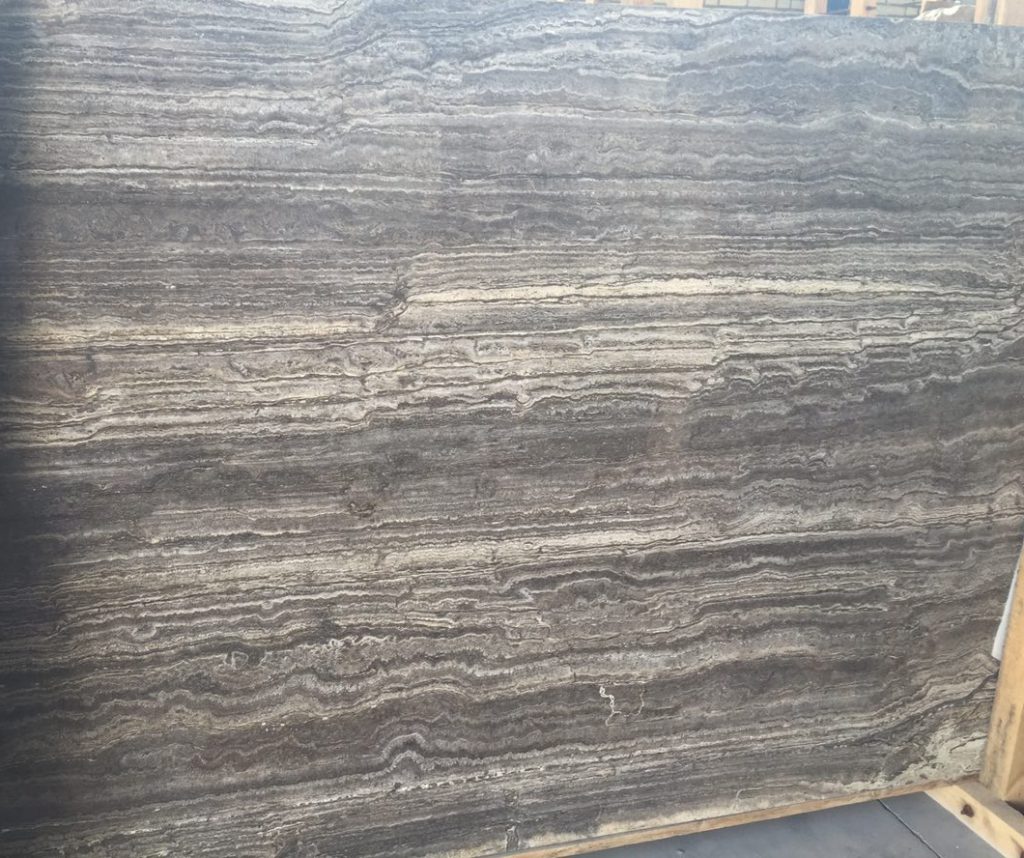Iranian Silver Travertine
Travertine stone is one of the most beautiful building stones that is widely used by architects and builders. Iran’s travertines are mostly light colored, but there are also dark colored travertines that have their own charm. Iranian Silver travertine stone is one of those that is prominent among Iranian travertines with its silver to black background. The main quarries of this travertine are located in the cities of Takab, Azarshahr and Kashan. The presence of streaks or the layering of light and dark colors is one of the important features of silver travertine, which has given this stone a special beauty.
In the following, different characteristics of Iranian silver travertine are examined.

Appearance, textural and chemical characteristics of Iranian silver travertine stone
Iranian Silver travertine has a range of colors from light silver to tan. The dark and light smoky background color with very beautiful white, black, silver and sometimes yellow waves and streaks has increased the beauty of silver travertine. Takab Iranian silver travertine in West Azarbaijan and Azarshahr quarries in East Azarbaijan are usually of high quality and have a higher price; Kashan silver travertine stone is also in the next place. But what is the reason for creating such colors in the layering of Travern Silver stone?
Water from mineral and travertine springs often passes through different layers of the earth after several stages and flows out.
Travertine-making waters have three sources: surface, deep and mixed. Waters of surface origin, which are known as geothermal waters, are of out side origin and they are formed from water sinking deep into the ground and sometimes to great depths. The presence of many mountains, folds, and especially fractures and faults are the important factors of the outflow of water from travertine mineral springs.
Travertine is a sedimentary stone that forms around hot springs and sometimes rivers and streams. In general, travertine is considered as a non-marine carbonate and sedimentary stone that forms in dry intercontinental environments. Iranian Silver travertine occurs around hot springs. In these areas, atmospheric water enters the ground through fault fractures and stone mass cracks and reaches near the igneous masses that have already been injected in the area. The heating of the water around the igneous masses causes its density to decrease and move upwards, i.e. the surface of the earth.
Hot waters, which are also acidic, dissolve different stone parts in their path. Most of these stone are carbonate, as a result, the dominant chemical composition in hydrothermal solutions will also be carbonate.
Although dissolution of ferrous compounds may also occur. Sometimes, along this path, there are also dark colored organic materials with carbon elements in the stone, which are dissolved by hot solutions. The exit of hydrothermal solutions from the springs and their deposition around the springs happens in a layered manner, as a result of which, the sequence of light to dark and sometimes yellow colors is formed, which is one of the characteristics of silver travertine.
It is necessary to explain, when these solutions reach the surface of the earth and the petrification process has not yet taken place in them, microscopic organisms begin to multiply in them, which are able to absorb the carbon element in the soft tissue and crust are their own.
Gradually, with the growth of these organisms, the organic materials from the fossils of these organisms are also included in the chemical composition of the stone, and it is considered another factor in the darkness of Iranian silver travertine stone; Therefore, the background color of travertine silver is the result of the combination of iron and carbon elements, although other elements such as manganese can also be traced in small amounts in the chemical composition of this stone.
Gradually, with the growth of these organisms, the organic materials from the fossils of these organisms are also included in the chemical composition of the stone, and it is considered another factor in the darkness of Iranian silver travertine stone; Therefore, the background color of travertine silver is the result of the combination of iron and carbon elements, although other elements such as manganese can also be traced in small amounts in the chemical composition of this stone.
The darker the Iranian silver travertine layering, the higher the percentage of iron and carbon elements in it. Most metallic elements appear in the chemical composition of calcite mineral, which is the dominant mineral in silver travertine, and rarely can appear as other minerals. It should be noted that aragonite mineral can also be present in this stone along with calcite mineral, which can be identified by its mostly needle-shaped structure.
Iranian Silver travertine is cut and processed in two types, cross cut and vein cut. Iranian Silver travertine waves, which are basically layers of travertine during stone formation, have different types. In Takab silver travertine, generally, the regularity of the waves is less and the color difference between the dark and light parts is also less. Azarshahr Travertine Silver has almost the same conditions. But in Kashan silver travertine, the color difference between the layers is more and the waves are relatively more orderly. Although Takab and Azarshahr Iranian silver travertine are of higher quality and price, some architects tend to use Iranian silver travertine with regular waves. The order or irregularity in the Iranian silver travertine texture can have many reasons. Travertine is a stone with a layered structure. That is, first the lower layers are formed and then the next layers are placed on top of them. If the ground has morphological irregularities in the place of deposition, the first layer covers these irregularities and then the upper layers are deposited parallel and regularly. In this case, the lower layers will be irregular, but gradually as the sedimentation process progresses, The order of the layers increases. On the other hand, the order of the layers may decrease in two cases:
- If the concentration of the solutions coming out of the springs changes a lot in different periods of time, in this case, not only the color of the layers changes, but due to the change in the speed of movement of the solutions on the surface of the earth, smooth and linear or chaotic currents may be formed alternately. In a calm state, the layers will have an orderly state, but in a turbulent state, the deposited layers will also take on an irregular and chaotic state.
- If, in the process of settling sediments and forming travertine layers, dynamic and instantaneous stresses are applied to it, the stone layers will be formed irregularly. These stresses can be caused by earthquakes during the formation of travertine layers.

© Copyright 2023 M.STONE TRADING


